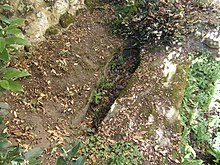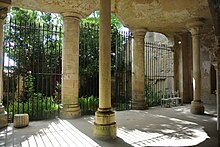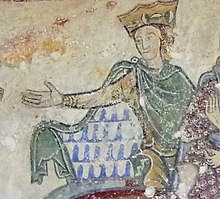Chapelle Sainte-Radegonde
The site has probably been known since antiquity as a well whose waters were reputed to be miraculous; tradition has it that the hermit Jean le Reclus was buried there; the main developments leading to the creation of a proper chapel, however, date back to the 11th or 12th century.
The walls are decorated with several murals from different periods and in varying states of preservation; one of them, probably depicting a hunting scene, dates from the end of the 11th century.
The various cavities are dug into the Upper Turonian yellow tuffeau, a sedimentary rock that has been widely exploited in the middle Loire Valley and its tributaries for construction since Antiquity.
[4] The Sainte-Radegonde site in Chinon appears to have been occupied as early as the Hallstatt period, as evidenced by the remains of "surface" settlements and pottery shards found on the hillside above the chapel.
[8] Curative virtues were attributed to the water drawn from the well on the night of St. John's Day (summer solstice), but this reference probably came later, in connection with the occupation of the site by a hermit named Jean.
[17] During the Late Roman Empire and the High Middle Ages, many pagan cult sites, including those associated with springs, were Christianized within or near churches or chapels, if they were not destroyed.
[11] Perhaps at the end of the 11th[19] or beginning of the 13th century, the vault partially collapsed on the south side, leaving the building unable to accommodate the large number of worshippers and pilgrims.
[13] In 1388–1402, chronicles record the burial of local personalities in the chapel, including two nuns and a notable Chinonite who became a hermit after a pilgrimage to Jerusalem.
Twenty years later, it was used as lodgings for carers and the families of patients suffering from an epidemic of plague or typhoid fever[21] then raging in Touraine.
[22] Disused during the French Revolution, the chapel was sold as bien national in 1793 and transformed, along with adjoining cavities to the west, into four different dwellings.
This situation, punctuated by various changes of ownership, lasted for almost a century; during this period, and on the initiative of the owners, excavations took place in an attempt to recover bones and furniture from the various tombs.
[22] In the nineteenth century, as part of the various restructuring and restoration work carried out on the building, an ossuary was built in the troglodytic nave to house the ashes of previous burials.
[22] In the course of the clearing, cleaning and restoration work carried out by this society from 1960[23] onwards, in 1964 they discovered the painting of the "Royal Hunt" hidden under several layers of whitewash, and the well filled in with 19th-century garbage.
In its western section, at the presumed site of his tomb, is a recumbent statue of Saint Jean-le-Reclus with the inscription "Il s'est endormi dans le Seigneur" ("He has fallen asleep in the Lord"); the painting of the "Royal Hunt" can be found on the part of the north wall adjacent to this monument.
Like the troglodytic nave, it has a semicircular apse at its eastern end - temporarily walled up in the 17th century - but does not appear to be decorated with paintings.
In its south-western corner, two burials dug side-by-side into the rock are visible, in which the bodies were placed head to the west and feet to the east.
Merovingian sarcophagi and statues from the collections of the Société d'histoire de Chinon Vienne et Loire are on display in the underground nave.
[31] To the north and west of the chapel, two sets of galleries linked by passages cut into the rock and partially partitioned by masonry walls formed two separate, entirely troglodytic dwellings in the 19th century, each with its own entrance and front windows.
As part of the Musée des Arts et Traditions Populaires du Chinonais, walnut oil presses from the 18th century and a variety of everyday objects are on display in the part of the complex formerly used as dwellings, which also includes a former bread oven.The underground nave was painted at various times, in several places in the northern aisle.
[7] The most extensively studied and discussed element of the chapel's decoration, a painting located at the top of the north wall of the troglodytic nave, discovered in August 1964, measures 2.15 m long by 1.15 m high.
[43] Whether it's a hunting scene, a departure into captivity or a newlyweds' journey, none of these proposals displays a strong sacred symbolism, due to the absence of religious figures; the fact that the painting was executed in a chapel and that the procession heads towards the choir like a pilgrimage is no doubt not insignificant[31] At the time of its discovery and in the late 1990s, art historians suggested that the painting's pictorial style and potential subject matter point to its completion in the last decades of the XIth century or at the beginning of the XIII century.
[48] The walls and vault of the niche occupied by Jean's recumbent bed were decorated with red paint in the 15th century, but only remnants remain.
[49] The walls of the eastern chapel, known as the "Chapelle Sainte-Radegonde", which provides access to the well and complex cavity system, are decorated with scenes from the lives of Radegonde and Jean; these 17th-century paintings were extensively restored in the 19th century, with the sky repainted blue with gold stars.








